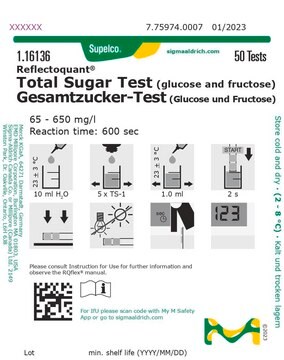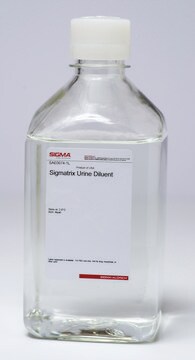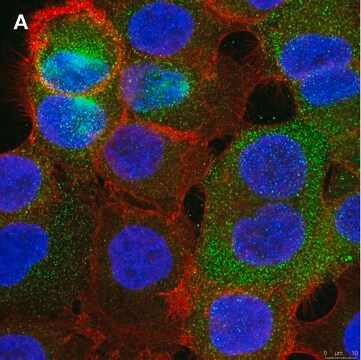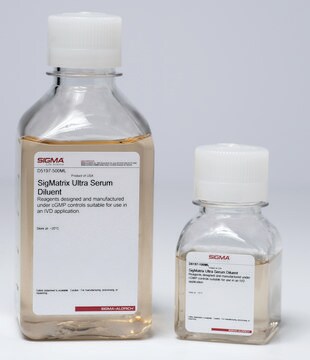MAB1217F
Anti-FMC-7 B-Cell Lymphocyte Marker Antibody, clone FMC-7, FITC conjugated
clone FMC-7, Chemicon®, from mouse
Sinônimo(s):
Anti-FMC-7, B-Cell Marker Detection, FITC Anti-FMC-7
Faça loginpara ver os preços organizacionais e de contrato
About This Item
Código UNSPSC:
12352203
eCl@ss:
32160702
NACRES:
NA.41
Produtos recomendados
fonte biológica
mouse
Nível de qualidade
conjugado
FITC conjugate
forma do anticorpo
purified immunoglobulin
clone
FMC-7, monoclonal
reatividade de espécies
human
fabricante/nome comercial
Chemicon®
técnica(s)
flow cytometry: suitable
Isotipo
IgM
Condições de expedição
wet ice
modificação pós-traducional do alvo
unmodified
Descrição geral
B cells are lymphocytes that play a large role in the humoral immune response as opposed to the cell-mediated immune response that is governed by T cells. The principal function of B cells is to make antibodies against soluble antigens. B cells are an essential component of the adaptive immune system. FMC-7 B-Cell Lymphocyte Marker is a 105 kDa B cell restricted antigen which is expressed on about 50% of adult human peripheral blood B cells. Upon in vivo B cell activation FMC7 expression initially increases. B cells involved in antibody secretion have lost the FMC7 determinant. The monoclonal antibody FMC7 delineates a subpopulation of B lymphocytes in normal blood. Expression of the antigen recognized by FMC7 appears to be maturation-linked, and it serves to distinguish different types of B cell leukemia.
BIOCHEMISTRY: p I = 7.4
Especificidade
The FMC-7 antibody was not clustered at the 5th Leucocyte Typing Workshop held in Boston USA 1993. This antibody detects a glycoprotein of 105kD found on circulating B-lymphocytes (Brooks et al., 1981). Studies on normal lymphocytes, leukaemic cells and cell lines indicate that FMC-7 is a marker for a limited segment of the B cell maturation pathway (Catovsky et al., 1981; Zola et al., 1984). This glycoprotein is expressed in varying degrees on normal circulating B-cells, chronic B-cell leukaemia (B-CLL), prolymphocytic leukaemia (PLL) and other B cell neoplasias (Zola et al., 1984, 1987; Bloem et al., 1988; Melo et al., 1988; Ferro & Zola, 1990; Mulligan, 1990; Zola et al., 1991; Burthem & Cawley, 1994; Huh et al., 1994). It labels the same population as CD22 antibodies but reacts with a different antigen (Zola et al. 1987).
Cell reactivity:1
Stains peripheral blood B lymphocytes and tonsil B lymphocytes. No reaction with granulocytes, monocytes, platelets, erythrocytes, T lymphocytes or null cells. Reacts with HRIK and Raji cell lines.
Clinical9,12,13 Expression
B cell prolymphocytic leukemia (B-PLL) Strongly positive
Hairy cell leukemia (HCL) Strongly positive
Hairy cell leukaemia variant (HCL-V) Strongly positive
Splenic lymphoma with villous lymphocytes (SLVL) Positive
B cell chronic lymphocytic leukaemia (B-CLL) Negative to weakly positive
Cell reactivity:1
Stains peripheral blood B lymphocytes and tonsil B lymphocytes. No reaction with granulocytes, monocytes, platelets, erythrocytes, T lymphocytes or null cells. Reacts with HRIK and Raji cell lines.
Clinical9,12,13 Expression
B cell prolymphocytic leukemia (B-PLL) Strongly positive
Hairy cell leukemia (HCL) Strongly positive
Hairy cell leukaemia variant (HCL-V) Strongly positive
Splenic lymphoma with villous lymphocytes (SLVL) Positive
B cell chronic lymphocytic leukaemia (B-CLL) Negative to weakly positive
Imunogênio
The human B-lymphoblastoid cell line, HRIK.
Aplicação
Research Category
Inflammation & Immunology
Inflammation & Immunology
Research Sub Category
Immunoglobulins & Immunology
Immunoglobulins & Immunology
This Anti-FMC-7 B-Cell Lymphocyte Marker Antibody, clone FMC-7, FITC conjugated is validated for use in Flow Cytometry (FC) for the detection of FMC-7 B-Cell Lymphocyte Marker.
This antibody can be used for the differentiation of PLL from B-CLL. It is also useful in confirmation of the diagnosis of other disorders such as HCL, HCL-V and SLVL. Useful for the detection of residual disease in patients undergoing treatment for these disorders.
SUGGESTED USAGE:
Flow cytometry - use 10 μl direct from the vial per 100 μl of whole blood, or 1 x 10E6 peripheral blood mononuclear cells (PBMC) in 100 μl buffer.
SUGGESTED USAGE:
Flow cytometry - use 10 μl direct from the vial per 100 μl of whole blood, or 1 x 10E6 peripheral blood mononuclear cells (PBMC) in 100 μl buffer.
Descrição-alvo
105 kDa
Ligação
Replaces: CBL1416F
forma física
The antibody is supplied in 1.0 ml 0.1M Tris-HCl, 0.5M NaCl, 10mM glycine, pH 8.0, containing 0.2% bovine serum albumin and 0.1% sodium azide. The characteristics of each lot are tested by electrophoresis and flow cytometry.
Armazenamento e estabilidade
Store at 2 to 8°C, for up to 6 months. DO NOT FREEZE. Protect from light.
WARNING: The monoclonal reagent solution contains 0.1% sodium azide as a preservative. Due to potential hazards arising from the build up of this material in pipes, spent reagent should be disposed of with liberal volumes of water.
WARNING: The monoclonal reagent solution contains 0.1% sodium azide as a preservative. Due to potential hazards arising from the build up of this material in pipes, spent reagent should be disposed of with liberal volumes of water.
Nota de análise
Control
Human peripheral blood lymphocytes, HRIK and Raji cell lines
Human peripheral blood lymphocytes, HRIK and Raji cell lines
Informações legais
CHEMICON is a registered trademark of Merck KGaA, Darmstadt, Germany
Exoneração de responsabilidade
Unless otherwise stated in our catalog or other company documentation accompanying the product(s), our products are intended for research use only and are not to be used for any other purpose, which includes but is not limited to, unauthorized commercial uses, in vitro diagnostic uses, ex vivo or in vivo therapeutic uses or any type of consumption or application to humans or animals.
Código de classe de armazenamento
12 - Non Combustible Liquids
Classe de risco de água (WGK)
nwg
Ponto de fulgor (°F)
Not applicable
Ponto de fulgor (°C)
Not applicable
Certificados de análise (COA)
Busque Certificados de análise (COA) digitando o Número do Lote do produto. Os números de lote e remessa podem ser encontrados no rótulo de um produto após a palavra “Lot” ou “Batch”.
Já possui este produto?
Encontre a documentação dos produtos que você adquiriu recentemente na biblioteca de documentos.
Nossa equipe de cientistas tem experiência em todas as áreas de pesquisa, incluindo Life Sciences, ciência de materiais, síntese química, cromatografia, química analítica e muitas outras.
Entre em contato com a assistência técnica








